Knee osteoarthritis (OA) is a common joint condition, especially as we get older. It’s characterized by pain, stiffness, and swelling, which can seriously impact daily activities. As OA becomes more prevalent, researchers are continuously exploring new ways to manage the condition. One such treatment gaining attention is the intra-articular injection of hyaluronic acid (IAAH), which is showing promise as an alternative to traditional painkillers like nonsteroidal anti-inflammatory drugs (NSAIDs).
IAAH injections aim to improve joint function by restoring the viscosity and elasticity of the synovial fluid in the knee, essentially providing lubrication to reduce friction. Recent research indicates that these injections may be more effective and have fewer side effects than NSAIDs, making them a favorable option for many patients. However, the level of evidence for their effectiveness can vary, and they may not be suitable for everyone.
A group of 12 experts from eight European countries, known as the EUROVISCO group, recently reached a consensus on the use of IAAH for knee OA. Their findings, published in the Cartilage journal, suggest that IAAH injections are a good treatment option for symptomatic knee OA, regardless of age or comorbidities, but they should be avoided during flare-ups or in cases of significant knee swelling.
The EUROVISCO experts emphasized the importance of identifying which patients will benefit most from IAAH. For example, these injections are generally well tolerated and suitable for people with conditions like diabetes, metabolic syndrome, and cardiovascular disease. However, they are not recommended during pregnancy or breastfeeding unless necessary. It’s also important to note that IAAH injections are most effective in the earlier stages of knee OA before significant damage has occurred.
So, should you consider this treatment? If you’re experiencing knee pain and other treatments haven’t worked, hyaluronic acid injections might be worth discussing with your doctor. While not a cure, they offer a promising way to manage knee OA symptoms, particularly if you’re trying to avoid surgery.




